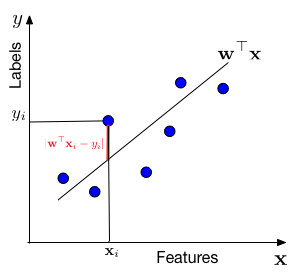Assumptions
 Data Assumption: \(y_{i} \in \mathbb{R}\)
Data Assumption: \(y_{i} \in \mathbb{R}\)
Model Assumption: \(y_{i} = \mathbf{w}^\top\mathbf{x}_i +
\epsilon_i\) where \(\epsilon_i \sim N(0, \sigma^2)\)
\(\Rightarrow y_i|\mathbf{x}_i \sim N(\mathbf{w}^\top\mathbf{x}_i, \sigma^2)
\Rightarrow
P(y_i|\mathbf{x}_i,\mathbf{w})=\frac{1}{\sqrt{2\pi\sigma^2}}e^{-\frac{(\mathbf{x}_i^\top\mathbf{w}-y_i)^2}{2\sigma^2}}\)
In words, we assume that the data is drawn from a "line" \(\mathbf{w}^\top
\mathbf{x}\) through the origin (one can always add a bias / offset
through an additional dimension, similar to the
Perceptron). For each data point with
features \(\mathbf{x}_i\), the label \(y\) is drawn from a Gaussian with
mean \(\mathbf{w}^\top \mathbf{x}_i\) and variance \(\sigma^2\). Our task
is to estimate the slope \(\mathbf{w}\) from the data.
Estimating with MLE
\[ \begin{aligned} \mathbf{w} &=
\operatorname*{argmax}_{\mathbf{\mathbf{w}}}
P(y_1,\mathbf{x}_1,...,y_n,\mathbf{x}_n|\mathbf{w})\\ &=
\operatorname*{argmax}_{\mathbf{\mathbf{w}}} \prod_{i=1}^n
P(y_i,\mathbf{x}_i|\mathbf{w}) & \textrm{Because data points are
independently sampled.}\\ &=
\operatorname*{argmax}_{\mathbf{\mathbf{w}}} \prod_{i=1}^n
P(y_i|\mathbf{x}_i,\mathbf{w})P(\mathbf{x}_i|\mathbf{w}) &
\textrm{Chain rule of probability.}\\ &=
\operatorname*{argmax}_{\mathbf{\mathbf{w}}} \prod_{i=1}^n
P(y_i|\mathbf{x}_i,\mathbf{w})P(\mathbf{x}_i) &
\textrm{\(\mathbf{x}_i\) is independent of \(\mathbf{w}\), we only model
\(P(y_i|\mathbf{x})\)}\\ &=
\operatorname*{argmax}_{\mathbf{\mathbf{w}}} \prod_{i=1}^n
P(y_i|\mathbf{x}_i,\mathbf{w}) & \textrm{\(P(\mathbf{x}_i)\) is a
constant - can be dropped}\\ &=
\operatorname*{argmax}_{\mathbf{\mathbf{w}}} \sum_{i=1}^n
\log\left[P(y_i|\mathbf{x}_i,\mathbf{w})\right] & \textrm{log is a
monotonic function}\\ &= \operatorname*{argmax}_{\mathbf{\mathbf{w}}}
\sum_{i=1}^n \left[ \log\left(\frac{1}{\sqrt{2\pi\sigma^2}}\right) +
\log\left(e^{-\frac{(\mathbf{x}_i^\top\mathbf{w}-y_i)^2}{2\sigma^2}}\right)\right]
& \textrm{Plugging in probability distribution}\\ &=
\operatorname*{argmax}_{\mathbf{\mathbf{w}}}
-\frac{1}{2\sigma^2}\sum_{i=1}^n (\mathbf{x}_i^\top\mathbf{w}-y_i)^2 &
\textrm{First term is a constant, and \(\log(e^z)=z\)}\\ &=
\operatorname*{argmin}_{\mathbf{\mathbf{w}}} \frac{1}{n}\sum_{i=1}^n
(\mathbf{x}_i^\top\mathbf{w}-y_i)^2 & \textrm{Always minimize;
\(\frac{1}{n}\) makes the loss interpretable (average squared error).}\\
\end{aligned} \]
We are minimizing a loss function, \(l(\mathbf{w}) =
\frac{1}{n}\sum_{i=1}^n (\mathbf{x}_i^\top\mathbf{w}-y_i)^2\). This
particular loss function is also known as the squared loss or Ordinary
Least Squares (OLS). OLS can be optimized with gradient descent, Newton's
method, or in closed form.
Closed Form: \(\mathbf{w} = (\mathbf{X
X^\top})^{-1}\mathbf{X}\mathbf{y}^\top\) where
\(\mathbf{X}=\left[\mathbf{x}_1,\dots,\mathbf{x}_n\right]\) and
\(\mathbf{y}=\left[y_1,\dots,y_n\right]\).
Estimating with MAP
Additional Model Assumption: \(P(\mathbf{w}) =
\frac{1}{\sqrt{2\pi\tau^2}}e^{-\frac{\mathbf{w}^\top\mathbf{w}}{2\tau^2}}\)
\[ \begin{align} \mathbf{w} &=
\operatorname*{argmax}_{\mathbf{\mathbf{w}}}
P(\mathbf{w}|y_1,\mathbf{x}_1,...,y_n,\mathbf{x}_n)\\ &=
\operatorname*{argmax}_{\mathbf{\mathbf{w}}}
\frac{P(y_1,\mathbf{x}_1,...,y_n,\mathbf{x}_n|\mathbf{w})P(\mathbf{w})}{P(y_1,\mathbf{x}_1,...,y_n,\mathbf{x}_n)}\\
&= \operatorname*{argmax}_{\mathbf{\mathbf{w}}}
P(y_1,\mathbf{x}_1,...,y_n,\mathbf{x}_n|\mathbf{w})P(\mathbf{w})\\ &=
\operatorname*{argmax}_{\mathbf{\mathbf{w}}}
\left[\prod_{i=1}^nP(y_i,\mathbf{x}_i|\mathbf{w})\right]P(\mathbf{w})\\
&= \operatorname*{argmax}_{\mathbf{\mathbf{w}}}
\left[\prod_{i=1}^nP(y_i|\mathbf{x}_i,\mathbf{w})P(\mathbf{x}_i|\mathbf{w})\right]P(\mathbf{w})\\
&= \operatorname*{argmax}_{\mathbf{\mathbf{w}}}
\left[\prod_{i=1}^nP(y_i|\mathbf{x}_i,\mathbf{w})P(\mathbf{x}_i)\right]P(\mathbf{w})\\
&= \operatorname*{argmax}_{\mathbf{\mathbf{w}}} \left[\prod_{i=1}^n
P(y_i|\mathbf{x}_i,\mathbf{w})\right]P(\mathbf{w})\\ &=
\operatorname*{argmax}_{\mathbf{\mathbf{w}}} \sum_{i=1}^n \log
P(y_i|\mathbf{x}_i,\mathbf{w})+ \log P(\mathbf{w})\\ &=
\operatorname*{argmin}_{\mathbf{\mathbf{w}}} \frac{1}{2\sigma^2}
\sum_{i=1}^n (\mathbf{x}_i^\top\mathbf{w}-y_i)^2 +
\frac{1}{2\tau^2}\mathbf{w}^\top\mathbf{w}\\ &=
\operatorname*{argmin}_{\mathbf{\mathbf{w}}} \frac{1}{n} \sum_{i=1}^n
(\mathbf{x}_i^\top\mathbf{w}-y_i)^2 + \lambda|| \mathbf{w}||_2^2
\tag*{\(\lambda=\frac{\sigma^2}{n\tau^2}\)}\\ \end{align} \]
This objective is known as Ridge Regression. It has a closed form solution
of: \(\mathbf{w} = (\mathbf{X X^{\top}}+\lambda
\mathbf{I})^{-1}\mathbf{X}\mathbf{y}^\top,\) where
\(\mathbf{X}=\left[\mathbf{x}_1,\dots,\mathbf{x}_n\right]\) and
\(\mathbf{y}=\left[y_1,\dots,y_n\right]\).
Summary
Ordinary Least Squares:
-
\(\operatorname*{min}_{\mathbf{\mathbf{w}}} \frac{1}{n}\sum_{i=1}^n
(\mathbf{x}_i^\top\mathbf{w}-y_i)^2\).
- Squared loss.
- No regularization.
-
Closed form: \(\mathbf{w} = (\mathbf{X X^\top})^{-1}\mathbf{X}
\mathbf{y}^\top\).
Ridge Regression:
-
\(\operatorname*{min}_{\mathbf{\mathbf{w}}} \frac{1}{n}\sum_{i=1}^n
(\mathbf{x}_i^\top\mathbf{w}-y_i)^2 + \lambda ||\mathbf{w}||_2^2\).
- Squared loss.
- \(l2\text{-regularization}\).
-
Closed form: \(\mathbf{w} = (\mathbf{X X^{\top}}+\lambda
\mathbf{I})^{-1}\mathbf{X} \mathbf{y}^\top\).
 Data Assumption: \(y_{i} \in \mathbb{R}\)
Data Assumption: \(y_{i} \in \mathbb{R}\)